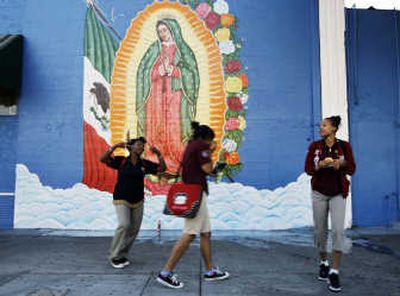Police say gang randomly killed blacks

LOS ANGELES – In a quest aimed at “cleansing” their turf of snitches and rival gangsters, members of one of Los Angeles County’s most vicious Latino gangs sometimes killed people just because of their race, an investigation found.
There were even instances in which Florencia 13 leaders ordered killings of black gangsters and then, when the intended victim couldn’t be located, said, “Well, shoot any black you see,” Los Angeles County Sheriff Lee Baca said.
“In certain cases some murders were just purely motivated on killing a black person,” Baca said.
Authorities say there were 20 deaths among more than 80 shootings documented during the gang’s rampage in the hardscrabble Florence-Firestone neighborhood, exceptional even in an area where gang violence has been commonplace for decades. They don’t specify the time frame or how many of the killings were racial.
Los Angeles has struggled with gang violence for years, especially during the wars in the late 1980s and early ‘90s between the Crips and the Bloods – both black gangs. Latino gangs have gained influence as the Hispanic population surged.
Evidence of Florencia 13, or F13, is easy to find in Florence-Firestone. Arrows spray-painted on the wall of a liquor store mark the gang’s boundary and graffiti warns rivals to steer clear.
The gang’s name comes from the neighborhood that is its stronghold and the 13th letter of the alphabet – M – representing the gang’s ties to the Mexican Mafia.
Federal, state and local officials worked together to charge 102 men linked to F13 with racketeering, conspiracy to murder, weapons possession, drug dealing and other crimes. In terms of people charged, it’s the largest-ever federal case involving a Southern California gang, prosecutors say. More than 80 of those indicted are in custody.
But eliminating the gang won’t be easy. It’s survived for decades and is believed to have about 2,000 members. Its reach extends to Nevada, Arizona and into prisons.According to the indictment, F13’s leader, Arturo Castellanos, sent word in 2004 from California’s Pelican Bay State Prison that he wanted his street soldiers to begin “cleansing” Florence-Firestone of black gangsters, notably the East Coast Crips, and snitches.
His followers eagerly obeyed, according to federal prosecutors.
The violence goes both ways, said Adam Torres, a Los Angeles County Sheriff’s Department gang detective whose beat includes Florence-Firestone.
During a recent patrol on the east side of the neighborhood, he pointed to a cinderblock wall peppered with bullet holes. Torres said the Crips still control that area and any Hispanic there is at risk of being shot.